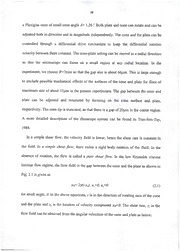Table Of ContentDISPERSIONOFFLOCCULATEDPARTICLES
INSIMPLESHEARANDELONGATIONALFLOWS
By
XUELIANGZHANG
ADISSERTATIONPRESENTEDTOTHEGRADUATESCHOOL
OFTHEUNIVERSITYOFFLORIDAINPARTIALFULFILLMENT
OFTHEREQUIREMENTSFORTHEDEGREEOF
DOCTOROFPHILOSOPHY
UNIVERSITYOFFLORIDA
1998
ACKNOWLEDGMENTS
Iwouldliketoexpressmysincereappreciationtothefollowingpeoplefortheirhelp
andsupportthroughoutmystudyattheUniversityofFlorida: Dr. Renwei Mei, my
advisor, constantly gave me his trust, advice, guidance and patience. Without his
commitmenttotheproject,thisdissertationcouldn'thavebeencompleted.Dr.Roger
Tran-Son-Tay, my co-advisor, offered me a great deal ofhelpful advice and expert
guidance in my experimental work. Dr. James F. Klausner, as a member ofmy
supervisorycommittee,gavemealotofguidanceandadvice,especiallyinmyearly
experimental work. Dr. Wei Shyy and Dr. Corin Segal served as members on my
supervisory committee, reviewed my proposal and dissertation, and made valuable
comments.Dr.BrijM.MoudgilandDr.HassanEl-Shallgavemetheirguidancesand
helps.Ms. EmmanuelleDemayandMr. PhilippeVigneronaidedmeinsomeofmy
experiments.Mr.RonBrownhelpedmeinthesetupofexperimentalapparatuses.Dr.A.
Zamam,Mr.J.Adler,Dr.J.S.Zhu,andDr.S.Mathurassistedmeinmakingfloesand
usesomeinstruments.
TheEngineeringResearchCenter(ERC)forParticleScience&Technologyatthe
UniversityofFlorida,theNationalScienceFoundation(Grantnumber:EEC-9402989),
andtheindustrialpartnersoftheERCprovidedthefinancialresourcesfortheproject.
Inaddition,mycolleaguesandfriendsattheUniversityofFlorida,Dr.JianLiu,Dr.
GuobaoGuo,Dr.HongOyang,MsHongShang,andMr.CunkoHu,providedmewith
varioushelpsinmystudyandlifeinGainesville,Florida.Iamalsogratefultothestaffat
theAeMESdepartmentalofficefortheirhelps.
SpecialthanksaregiventoMr.DarrellD.WilliamsatBristol,Englandforhishelp
andencouragementduringthepasttenyears.
Lastbutmostimportant,Iamdeeplyindebtedtomywife,Jie,forherunderstanding,
encouragement,patience,andlove.
TABLEOFCONTENTS
Pages
ACKNOWLEDGMENTS
ii
ABSTRACT
vi
CHAPTERS
1. INTRODUCTION 1
1.1Background 1
1.2LiteratureReview 2
1.3ObjectivesandScope 6
2. VISUALIZATIONOFFINEFLOCBREAKUPPROCESS 9
2.1ExperimentalDevices 9
2.1.1Cone-plateDeviceandFlowDescription 9
2.1.2HyperbolicFlowDeviceandFlowCharacteristics 13
2.1.3ContractileFlowChamber 19
2.2ExperimentalDevicesandMaterials 20
2.2.1Floes 20
2.2.2SuspendingFluids 22
2.3ResultsandDiscussions 23
2.3.1FloeBreakupinCone-plateShearFlow 23
2.3.2FloeDeformationandBreakupinContractileFlow 26
2.3.3FloeBreakupinHyperbolicFlow 33
2.4Summary 37
3. FLOCBREAKUPINSIMPLESHEARFLOWANDFLOCSTRENGTH 38
3.1Introduction 3g
3.2ExperimentalProcedureandDataProcessing 39
iii
1
3.3ResultsandDiscussions 42
3.3.1VariationofFloeMasswithTimeunderaConstantShearing 42
3.3.2VariationofFloeSizewithTimeatConstantShearRates 50
3.3.3VariationofFloeSizeandSizeDistributionwithShearStress 54
3.3.4ChangeofFloeShapewithTimeandStress 58
3.4Summary 62
FLOFCLBORWECAHKAURPAICNTOERRIIFZIACTEIFOLNOW-PART1 63
4.1Introduction 63
4.2Formulation 65
4.2.1GoverningEquationandBoundaryConditions 65
4.2.2GridArrangementandNumericalSchemes 68
4.2.3ValidationoftheNumericalMethod 72
4.3ResultsandDiscussions 75
4.3.1BasicFeaturesofOrificeFlowField 75
4.3.2StrainRateCharacteristicsofOrificeFlow 79
4.3.3MaximumCenterlineVelocityGradient 81
4.3.4ComparisonBetweenaxisymmetricFlowandTwo-dimensional
Flow g7
4.4Summary gy
FLOCBREAKUPINORIRICEFLOW-PART2
MEASUREMENTS
90
5.1Introduction 91
5.2ExperimentalApparatusandProcedure .92
5.2.1OrificeSetupandProcedure 92
5.2.2CouetteShearDevice 94
5.2.3ParticleSizeAnalyzer 9g
5.2.4EstimateofReflocculationinCouetteFlowandOrificeFlow 102
5.3ResultsAndDiscussions 104
5.3.1EffectofFlowConditiononFloeSizeDistribution 107
5.3.2DependenceofMeanFloeSizeandMaximumFloeSize
onFlowRate
11
5.3.3ComparisonwiththeResultfromUniformCone-plate
SimpleShearFlow
jj5
iv
5.3.4ComparisonofFloeDispersionbetweenOrificeFlow
andCylindricalCouetteFlow 119
5.3.5Re-ExaminationofSonntag'sExperimentalData 123
5.3.6FloeStrengthAssessment 125
5.4Summary 129
SUMMARY
6. 131
6.1SummaryandConclusions 131
6.2SuggestionsforFutureStudies 134
REFERENCE 136
BIOGRAPHICALSKETCH 140
V
AbstractofDissertationPresentedtotheGraduateSchool
oftheUniversityofFloridainPartialFulfillmentofthe
RequirementsfortheDegreeofDoctorofPhilosophy
DISPERSIONOFFLOCCULATEDPARTICLES
INSIMPLESHEARANDELONGATIONALFLOWS
By
XueliangZhang
May1998
Chairman:Dr.RenweiMei
Co-Chairman:Dr.RogerTran-Son-Tay
MajorDepartment:AerospaceEngineering,MechanicsandEngineeringScience
Experimentalstudiesonthedispersionprocessoffineflocculatedparticlesindifferent
flowsarecarriedoutthroughvisualimageanalysesandparticlesizemeasurements.The
flowsinvestigatedincludeacone-plateshearflow,acylindricalCouetteflow,anorifice
contractileflow,andahyperbolicflow.
Visualstudiesonthemechanismsoffloebreakupindifferentflowsarefirstconducted
throughavideoimageacquisitionandanalysissystem.Avarietyofdynamicprocessesof
thedeformationandbreakupoffinefloesofsizefrom3mmto30mminthecontractile
flow,hyperbolicflow,andsimpleshearflowarevisualized.Thebreakupanderosion
processoffloessubjectedtoaconstantshearstressinthecone-plateflowisanalyzed
basedonthechangesoffloemass,size,andshapewithshearstressandshearingtime
throughtheimageanalysis.Asignificantportionofthebreakup,orsizereduction,ofthe
vi
finefloestakesplaceupontheapplicationoftheshearstress. Floesizecontinuesto
decreasethrough erosionmechanism. Theerosionrate depends on the applied shear
stress,thefloesize,andthefloeshape.
Anorificeflowisappliedtobreakfloesanddeterminefloestrength.Theflowfield
beforeanorificeofhigharearatioisfirstnumericallysimulatedandanalyzedinorderto
characterize the flow and stress field. The dependence ofthe maximum centerline
velocitygradientonorificearearatioandReynoldsnumberisobtainedanditsasymptotic
behaviorinhighReynoldsnumberregimeisanalyzed.
The dispersion offloes in the orifice flow is analyzed based on the floe size
distributionmeasuredusingaparticlesizeanalyzer.Duetotherapidriseoftheaxial
velocity gradient near the orifice entrance, the floe breakup in the orifice flow is
instantaneousandthefloeerosionmechanismcanbeexcluded.Thecenterlinemaximum
shearstressintheorificeflowthusgivesthefloestrengthoftheresultingfloeswhose
averagesizeissubsequentlymeasured.Thefloestrengthdeterminedfromtheshort-time
shearinginacylindricalCouetteflowatlowershearstressesfollowsessentiallythesame
powerlawdependenceonthefloe sizeasdeterminedintheorificeflow. Thus, floe
strengthmeasuredindifferentflowscanbeunifiedusingthemaximumshearstressofthe
flow.
vii
CHAPTER
1
INTRODUCTION
1.1Background
Many modern advanced materials, such as electronic, magnetic, optic, and fine
ceramic materials, are produced from suspensions of colloidal particles. Floes or
aggregates are loose, irregular, three-dimensional clusters of particles in such
suspensions.Thewords,floeandaggregateusuallyarebothusedtorefertothewet
powderstructureinliquids.Highperformanceofmaterialsrequiressufficientdispersion
ofthe floes in suspensions, that is, sufficientbreakup offloes into smaller floes or
constituentparticles.Althoughthisdispersionprocessisactuallytheresultofanumber
ofdifferentstepsincludingmilling,mixing,stirring,andsoon,hydrodynamicshearing
playsanimportantroleincontrollingthestabilityanduniformityofthesuspensionsince
thedispersionprocessisusuallycarriedoutinahydrodynamic environmentwithor
withouttheaidofdispersants.Theflocculation(particlesizeenlargement)ofparticles
and redispersion (particle size reduction) of flocculated particles take place
simultaneouslyandconstantlyintheflowenvironmentofthesolid-liquidsuspension.
Animportantcharacteristicoffloesistheirbindingforce,thatis,theabilityofthe
aggregate structureto resist deaggregation. As ameasureofthisbinding force, floe
strengthcanbedefinedasresistancetobreakupbyshearforcesinducedbyfluidvelocity
gradients. Thequantitativeevaluationoffloestrengthisimportanttobothdispersion
l
2
processandflocculationprocess.However,itisunderstoodthatthestrengthoffloesina
suspensioncannotbemeasureddirectlyduetoitsspatiallyirregularstructureandthe
randomcharacteristicinitsformationbutmustbededucedfromtheevaluationofother
measurableparameters.Becausetheconceptof"strength"forfloesisalwaysassociated
withtheirbreakupwhichinvolvesdifferentmechanisms,thestudyonthefloestrength
shouldincludethemechanismsoffloebreakupandtheforcewhichcausesthisbreakup.
1.2LiteratureReview
Thomas(1964)gavethefirstanalysisonthemechanismsoffloebreakupandfloe
strength.Heproposedthatlargefloesinaturbulentflowfieldbreakintheformsofbulgy
deformationandrupture.Heassumedthatthepressuredifferenceontheoppositesidesof
afloecausesitsbulgydeformationandeventualruptureandthatthepressuredifference
isduetotherandomvelocityfluctuationsofturbulentflow.Hisworkformedthebasis
foranumberofexperimentalinvestigationstodeterminefloestrengthsincethen.
BasedonThomas'modelsforfloerapturemechanismandisotropicturbulencetheory,
severalexperimentalstudiesoffloebreakupinturbulentflowshavebeenconductedto
determinethefloestrengthbyrelatingthefloe sizetotheturbulentflowconditions.
TamboandHozumi(1979)devisedaspecialflocculatorexperimenttostudyfloestrength
bymeasuringthemaximumfloediameterunderaweakagitation. Matsuo andUnno
(1981)usedaturbulentpipeflowtoevaluatefloestrength.BacheandAl-Ani(1989)used
averticalpulsatingwatercolumndrivenbyanoscillatingplungertorelatethefloesizeto
the turbulence energy dissipation. Moudgil, Springgate, and Vasudevan (1989)
experimentallystudiedthestrengthofkaolinite,dolomite,andA1203floesinastirred
tank. Theresultsforfloestrengthobtainedbytheapplicationofisotropicturbulence
theoryprovide some qualitative understandings offloe characteristics. However, the
shearfieldisspatiallynonuniforminastirringtankandonlytheoverallmeanenergy
dissipationratecanbeestimatedforflowdescriptionbasedonthepowerinput.Floe
breakup andreflocculation are usuallypresent simultaneously. Therefore, the results
obtained from such experiments do not suffice forthepurposes ofdetermining floe
strength.
Parker,Kaufman,andJenkins(1972)derivedamodelforthebreakupofcomplex
activatedsludgefloesandinorganicchemicalfloesbasedonthebreakupmodeofsurface
erosionsuggestedbyArgamanandKaufman(1970).Theyproposedthattheprimary
particlesarestrippedfromthesurfaceofafloebyfluidshearataratethatisproportional
tothefloesurfaceareaandthesurfaceshearingstress.
KaoandMason(1975)andPowellandMason(1982)usedafour-rollerdeviceintheir
experimentsoffloedeformationandbreakupinanelongationalflow.Thismaybethe
first systematic visual work to study aggregate dispersion in fluid flows. Couette
apparatushadalsobeenusedintheirstudyforthecaseofsimpleshear. Quigleyand
Spielman(1977,seeLuandSpielman, 1985)conductedsimilarexperimentsforferric
hydroxide agglomerates in a four-rollerdevice. It is important to note that in these
experimentsthesizeofprimaryparticlesfromwhichthefloesoraggregatesaregenerated
rangesfrom20umto400umandthesizeoffloesoraggregatesisabout3mm~5mm.
Sonntag and Russel (1986, 1987) investigated experimentally the structure and
propertiesofflocculatedsuspensionsinasimpleshearflowofcylindricalCouetteflow

